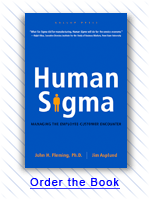To master the new discipline of the emotional economy, business leaders need a new way to think about "customer requirements" and a new set of tools to help structure their businesses around them. But exactly how should they construct a new definition of customer requirements?
Traditionally, the customer's perspective has been evaluated by assessing "conformance to requirements," often (though not always) by using a generic measure of customer satisfaction. Early practitioners of the quality movement postulated that customers would be satisfied with and would continue to purchase a product or service if it met their functional specifications and fulfilled their requirements.
 |
The origins of how "customer satisfaction" emerged as the preferred measure are a bit murky, but, for better or for worse, it seems to have been selected primarily based on its intuitive appeal. In other words, customer satisfaction seems so plausible that surely it must be the correct thing to measure. As a result, the issue of whether customer satisfaction actually measures anything of value appears to have been overlooked. [See "Customer Satisfaction Doesn't Count" in the "See Also" area on this page.]
Because the bulk of the work that laid the foundation for this perspective originated in manufacturing and process-intensive businesses, customer requirements have generally been specified in functional terms: Did the product have any defects? Did it conform to specified manufacturing tolerances and parameters? Was it delivered on time? And so on.
But as our knowledge of psychology, behavioral economics, and neuroscience has matured, we now recognize that this rational-functional view of human decision making is flawed and incomplete. To date, only advertisers have paid much attention to the essential non-rational and emotional dimensions that define what it means to be human -- and a customer. As a result, it's not surprising that executives and managers continue to struggle to understand why customers who appear to be satisfied defect to competitors -- and why authentic, organic growth remains elusive.
Customer satisfaction is not enough
Business leaders, researchers, academics, and management consultants alike have expressed concern that though customer satisfaction may be a necessary foundation for building strong customer relationships, by itself, it's a relatively poor indicator of future customer behavior. Our data support this concern.
Empirical results from a large and growing number of case studies suggest that customers who are extremely satisfied -- those who provide the highest rating of overall satisfaction with a company's products or services -- can be classified into two distinct groups: those who are emotionally satisfied and those who are rationally satisfied.
- Emotionally satisfied customers are extremely satisfied with the products and services the company provides and have a strong emotional attachment to the company.
- Rationally satisfied customers, in contrast, are also extremely satisfied with the company but lack the strong emotional connection of customers who are emotionally satisfied.
When we examine the indicators of customer behavior within these two customer groups, such as customer attrition, frequency of use, share of requirements/share of wallet, and total revenue and spending, among others, a clear and striking pattern emerges. Emotionally satisfied customers deliver enhanced value to a company, for example, by buying more products, spending more for those products, or returning more often to or staying longer with the business. Rationally satisfied customers, on the other hand, behave no differently than customers who are dissatisfied.
Consider the following case study from a large U.S. retail bank. When we assessed this bank's customers using an 11-item metric of customer engagement . . . we found that over a six-month period, emotionally satisfied customers ended their relationships with the bank by completely closing their accounts at rates that were 37% lower than rationally satisfied customers' rates. Dissatisfied customers, on the other hand, scarcely differed from rationally satisfied customers in their attrition levels.
Similar results emerged for an international credit card provider. Over a six-month period, emotionally satisfied cardholders spent on average $251 per month and used their cards an average of 3.1 times per month. Rationally satisfied cardholders, in contrast, spent on average just over half this amount ($136 per month) and used their cards less often (an average of 2.5 times per month) during the same period. Again, dissatisfied customers were virtually indistinguishable from rationally satisfied customers in their actual purchase behavior: Dissatisfied customers also spent on average $136 per month and used their cards an average of 2.2 times per month during the same period. And, emotionally satisfied cardholders increased their spending by 67% over a 12-month period, compared to an increase of just 8% among rationally satisfied customers. Once again, dissatisfied customers were virtually indistinguishable from rationally satisfied customers in terms of spending increases.
 |
This general pattern is consistent across every industry we have examined, leading us to this powerful conclusion: Customer satisfaction is not enough. Merely satisfying customers by delivering on their rational requirements represents a minimum point of entry for today's businesses; managing to satisfy customers will not drive the enhanced financial performance today's business leaders seek.
To build the strong customer connections that produce enhanced financial benefits, a more complete view of customer requirements is needed, which incorporates an understanding of the emotional dimensions of customer commitment. Customers want more than transactions -- they want relationships.
